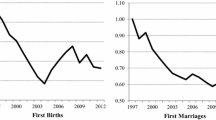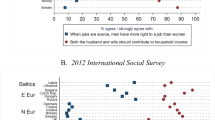Abstract
For some time now, the out-of-wedlock birthrate has been increasing rapidly in the United States. This has prompted several states to propose (and in some cases, enact) legislation to deny access to higher AFDC benefits for families in which the mother gives birth while receiving AFDC. The authors investigate whether AFDC benefit levels are systematically related to the family-size decisions of never-married women. Using a bivariate probit model with state and time fixed effects, applied to Current Population Survey data for the years 1980–1988, it is found that the basic benefit level for a family of two (one adult and one child) and the incremental benefit for a second child positively affects the family size decisions of black and Hispanic women, but not of white women. The effects are concentrated among high school dropouts (no effects are found for high school graduates). The authors conclude that rather than to uniformly deny benefits to all AFDC women that bear children, a better targeted policy might be to alter the AFDC benefit structure in such a way as to encourage single mothers to complete high school. However, being a high school dropout might be a proxy for some other underlying characteristic of the woman, and encouraging women to complete high school who otherwise would not might have no effect whatsoever on nonmarital births.
Similar content being viewed by others
References
Acs, G. (1993). The impact of AFDC on young women's childbearing decisions. Institute for Research on Poverty, Discussion paper No. 1011–93, University of Wisconsin-Madison.
Allen, D.W. (1993). Welfare and the family: The Canadian experience, Journal of Labor Economics 11 (1, Pt. 2): S201-S223.
An, C.B., Havemen, R. & Wolfe, B. (1990). The effect of childhood events and economic circumstances on teen fertility out-of-wedlock and the receipt of welfare: Estimates from a sequential decision model. Paper presented at Meetings of Population Association of America, Toronto, 1990.
Bassi, L. Aron, L., Barnow, B.S. & Pande, A. (1990). Estimates of expenditures on children and child support guidelines. Report submitted by Lewin/ICF to the Office of the Assistant Secretary for Planning and Evaluation, US Department of Health and Human Services.
Becker, G. (1960). An economic analysis of fertility, in A.J. Coala (ed.), Demographic and economic change in developed countries: A conference of the universities — National Bureau Committee for Economic Research, pp. 209–231. Princeton, NJ: Princeton University Press.
Becker, G. (1981). A treatise on the family. Cambridge, MA: Harvard University Press.
Bernstam, M.S. & Swan, P.L. (1986). The production of children as claims on the state: A comprehensive labor market approach to illegitimacy in the United States, 1960–1980. Working paper No. E-86-1. Hoover Institute, Stanford University.
Blau, D.M. & Robins, P.K. (1989). Fertility, employment, and child care costs, Demography. 26 (2): 287–299.
Cutright, P. (1970). AFDC, family allowances, and illegitimacy, Family Planning Perspectives 2 (4): 4–9.
Duncan, G.J. & Hoffman, S.D. (1990). Welfare benefits, economic opportunities, and out-of-wedlock births among black teenage girls, Demography 27 (4): 519–535.
Ellwood, D. & Bane, M.J. (1985). The impact of AFDC on family structure and living arrangements, in R. Ehrenberg (ed.), Research in labor Economics, pp. 137–207. Vol. 7, Greenwich, CT: JAI Press.
Fraker, T. Moffitt, R. & Wolf, D. (1985). Effective tax rates and guarantees in the AFDC Program, 1967–1982, Journal of Human Resources 20 (2): 251–263.
Freshcock, L. & Cutright, P. (1969). Models of illegitimacy: United States, 1969, Demography 16 (1): 37–47.
Fuchs, V. (1983). How we live. Cambridge, MA: Harvard University Press.
Gonul, F. (1988). An empirical analysis of the effects of AFDC on work, childbearing, and marital status decisions of young women. Unpublished manuscript, Graduate School of Industrial Administration, Carnegie Mellon University.
Hyatt, D. & Milne, W.J. (1991). Can public policy affect fertility? Canadian Public Policy 17 (1) 77–85.
Janowitz, B.S. (1976). The impact of AFDC on illegitimate birth rates, Journal of Marriage and the Family 38 (3): 485–494.
Keefe, D.E. (1983). Governor Reagan, welfare reform, and AFDC fertility, Social Service Review 57 (2): 234–253.
Lundberg, S. & Plotnick, R.D. (1990). Effects of state welfare, abortion, and family planning policies on premarital childbearing among white adolescents, Family Planning Perspectives 22 (6): 246–251.
Lundberg, S. & Plotnick, R.D. (1995). Adolescent premarital childbearing: Do economic incentives matter? Journal of Labor Economics 13 (2): 177–200.
Moffitt, R. (1992). Incentive effects of the US welfare system: A review, Journal of Economic Literature 30 (1): 1–61.
Moffitt, R. (1994). Welfare effects on female headship with area effects, Journal of Human Resources 29 (2): 621–636.
Murray, C. (1984). Losing ground: American social policy, 1950–1980. New York: Basic Books.
Murray, C. (1993). Welfare and the family: The US experience, Journal of Labor Economics 11 (1, Pt 2): S224-S262.
Olsen, R. (1994). Fertility and the size of the US labor force, Journal of Economic Literature 32 (1): 60–100.
Placek, D.S. & Hendershot, G.E. (1974). Public welfare and family planning: An empirical study of the brood sow myth, Social Problems 21 (5): 660–673.
Plotnick, R.D. (1990). Welfare and out-of-wedlock childbearing: Evidence from the 1980s, Journal of Marriage and the Family 52 (3): 735–746.
Polgar, S. & Hiday, V.A. (1974). The effect of an additional birth on low-income urban families, Population Studies 28: 463–471.
Power, E.T. (1994). The impact of AFDC on birth decisions and program participation. Working paper No. 9408. Federal Reserve Bank of Cleveland.
Presser, H.B. & Salsberg, L.S. (1975). Public assistance and early family formation: Is there a pronatalist effect? Social Problems 23 (2): 226–241.
Schultz, T.P. (1994). Marital status and fertility in the United States: Welfare and labor markets, Journal of Human Resources 29 (2): 637–669.
Southwick Jr, L. (1978). The effect of welfare programs on family stability, Review of Social Economy 36 (1): 19–40.
US Bureau of the Census (1993). Statistical abstract of the United States: 1993 (113th edition). Washington, DC.
Winegarden, C.R. (1974). The fertility of AFDC women: An econometric approach, Journal of Economics and Business 26: 159–166.
Winegarden, C.R. (1988) AFDC and illegitimacy ratios: A vector-autoregressive model, Applied Economics 20: 1589–1601.
Wood, R.G., Bloom, D., Long, D. & Fellerath, V. (1995). Encouraging school enrollment and attendance among teenage parents on welfare: Early impacts of Ohio's LEAP Program, Children and Youth Services Review 17 (1/2): 277–308.
Author information
Authors and Affiliations
Rights and permissions
About this article
Cite this article
Robins, P.K., Fronstin, P. Welfare benefits and birth decisions of never-married women. Popul Res Policy Rev 15, 21–43 (1996). https://doi.org/10.1007/BF00156741
Issue Date:
DOI: https://doi.org/10.1007/BF00156741




